Doc Venu Passion & Profession
Dr.Venugopalan.PP: Medical graduate of Govt. Medical College Calicut. Postgraduation Anaesthesiology and Emergency Medicine.Director and Lead Consultant in Emergency Medicine -Aster DM Health Care, Site Director-GWU, Regional Faculty AHA, Formerly Expert Committee member KRSA and Deputy Director MIMS Academy, Founder and Executive Director Angels International Foundation and Trust.Master Trainer in World Guinness CPR Training.Spouse Dr.Supriya; Blessed with Dr.Neethu and Dr.Kamal (Son in law)
Monday, May 5, 2025
Asianet Lifetime achievement Award 2025-Special Jury mention
Sunday, April 27, 2025
Two Movies You Shouldn’t Miss: Thadarum and Veera Dheera Sooran
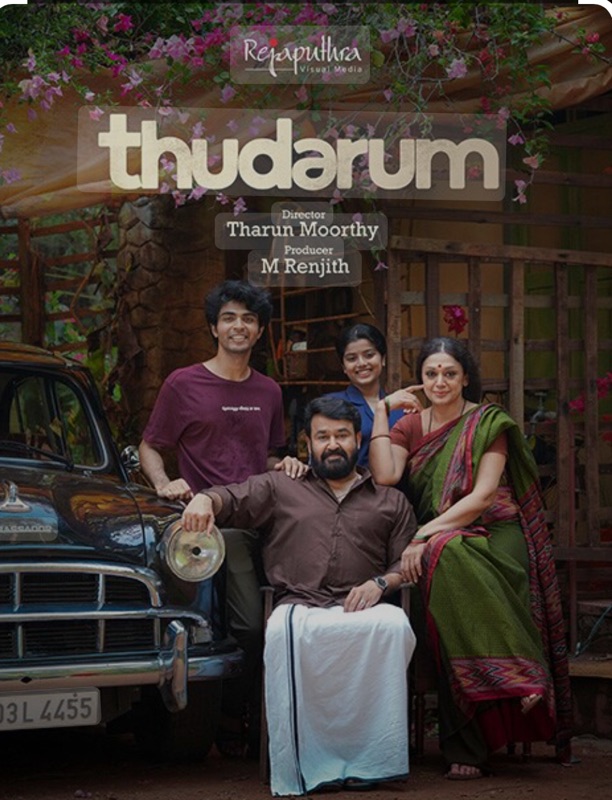
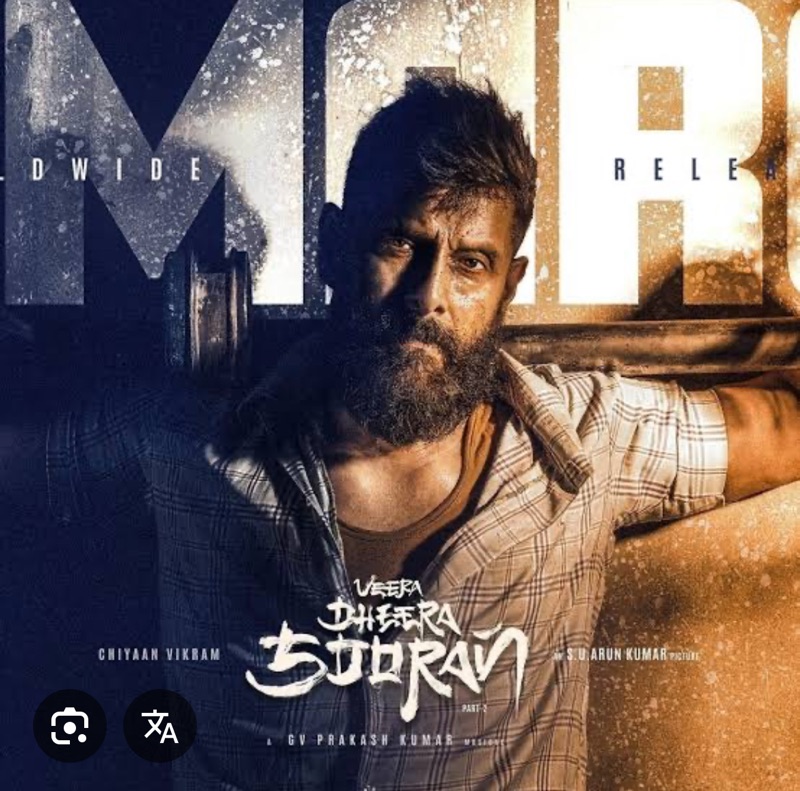 Two Movies You Shouldn’t Miss: Thadarum and Veera Dheera Sooran
Two Movies You Shouldn’t Miss: Thadarum and Veera Dheera Sooran
This weekend turned out to be a cinematic feast! Two movies left a deep impression on me — both blending family drama with intense crime thrillers, but in their own unique ways.
First, Thadarum — a Malayalam movie directed by the brilliant Tharun Moorthy and starring legends like Mohanlal, Prakash Varma, and Shobana — is currently streaming in theaters. I had the chance to watch it yesterday with my family, and what an experience it was!
In just one word: Phenomenal.
Mohanlal, under the guidance of a visionary director, has truly reclaimed his original magic. We have our organic and complete actor back, delivering a performance that reminds us why he remains an irreplaceable giant in Indian cinema. The family drama intertwined with gripping thriller elements makes Thadarum an unmissable movie for all cinephiles.
The second gem is Veera Dheera Sooran, starring the ever-versatile Vikram, now streaming on Amazon Prime. Sadly, this movie didn’t receive its deserved theatrical attention due to the overwhelming release of Empuraan. It barely found space in cinemas, but trust me, it’s a hidden masterpiece.
Vikram’s micro-acting — his subtle expressions, restrained emotions, and powerful presence — are simply breathtaking. Veera Dheera Sooran is a treat for those who appreciate nuanced performances layered within a tightly-woven crime drama and emotional storytelling.
Both these films reaffirm one thing:
When great actors meet great directors, magic happens.
If you’re looking for an engaging, emotional, and thrilling movie experience, add Thadarum and Veera Dheera Sooran to your watchlist — you won’t be disappointed!
Sunday, April 20, 2025
A Divine Meal at Seeta Rasoi Bhandara – Where Devotion Meets Simplicity
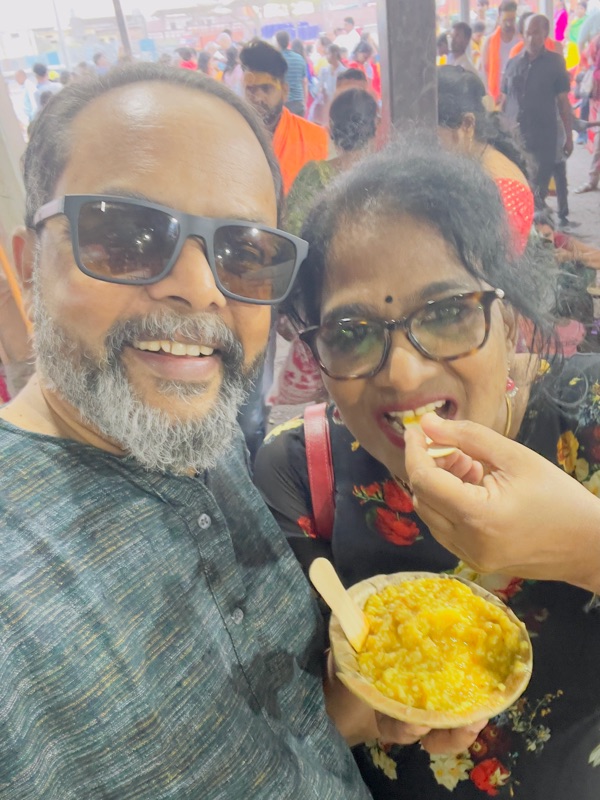 A Divine Meal at Seeta Rasoi Bhandara – Where Devotion Meets Simplicity
A Divine Meal at Seeta Rasoi Bhandara – Where Devotion Meets Simplicity
On a spiritually charged visit to the sacred city of Ayodhya, we found ourselves drawn to a humble yet powerful experience—Seeta Rasoi Bhandara, nestled near the Ram Janmabhoomi Mandir at Angad Tila.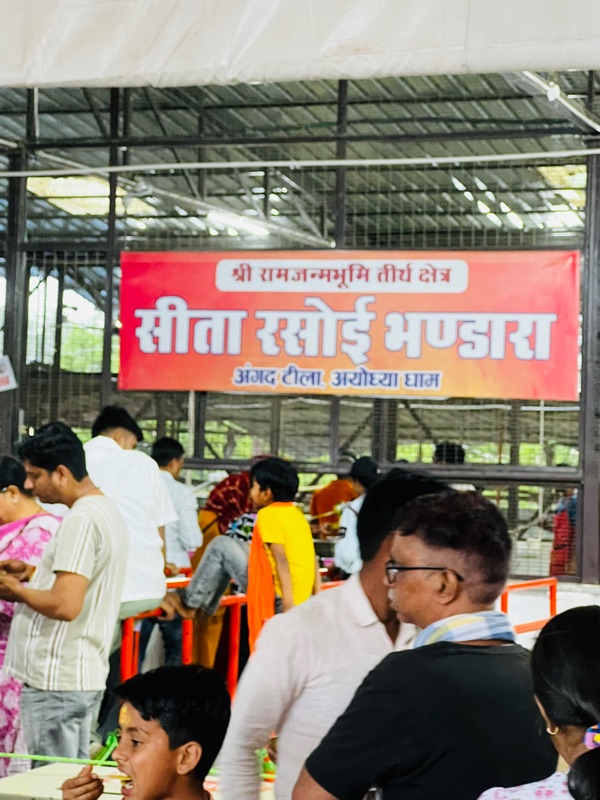
This wasn’t just a place to eat. It was a place where devotion simmered in every pot, where each grain of khichdi served felt like a blessing from Mata Sita herself. Named after the divine kitchen of Sita Devi, this Bhandara pays tribute to her role as the eternal nurturer, offering free satvik meals to thousands of pilgrims every day.
We stood in line with people from all walks of life—young, old, rich, poor—brought together by faith, sharing space and food with humility. The meal was simple: warm khichdi, served in a leaf bowl, eaten with wooden spoons. But the taste was enriched with something far deeper—gratitude, tradition, and grace.
As we savored each bite, smiling at the bustling crowd around us, it felt like time had slowed. In that moment, there was no hurry, no hierarchy—just a shared silence of reverence and fulfillment.
Seeta Rasoi is more than a kitchen. It is a memory, a message, and a moment of spiritual connection that will stay with us forever.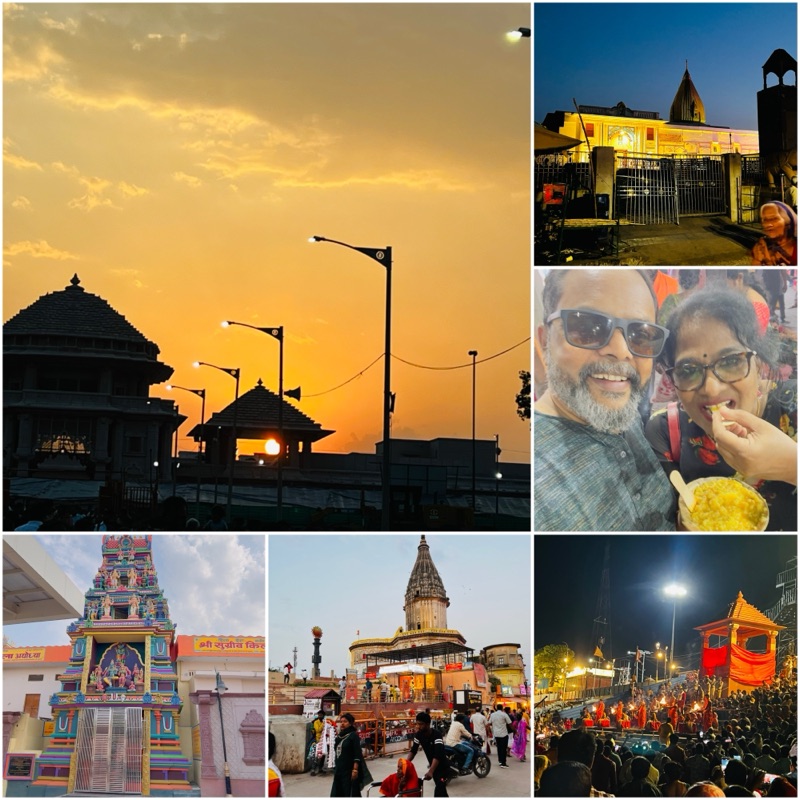
Monday, April 14, 2025
Sarayoo
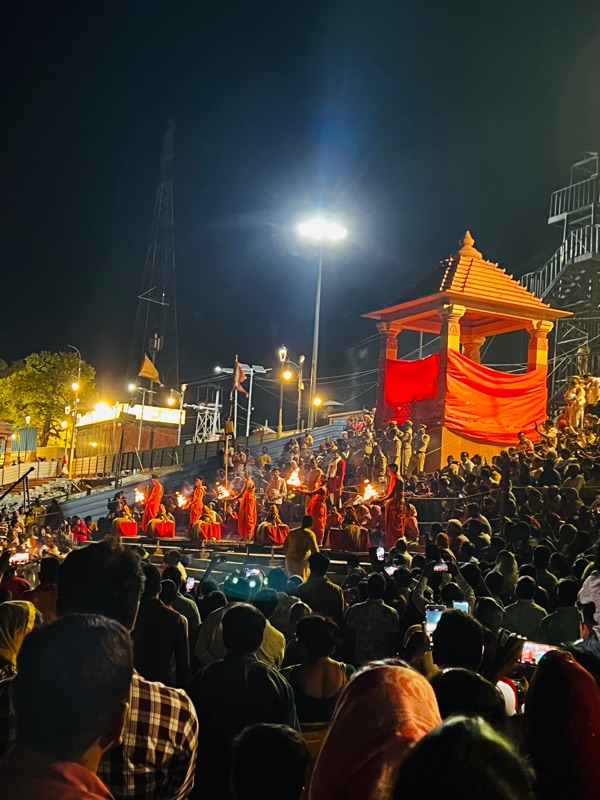
This photo captures the mesmerizing Ganga Aarti ritual on the banks of the Sarayu River in Ayodhya, Uttar Pradesh. The Sarayu, considered a sacred river in Hindu tradition, holds immense religious significance, especially as Ayodhya is believed to be the birthplace of Lord Rama.
Ritual Details:
1. Ganga Aarti Ceremony:
- Held in the evening, typically at sunset.
- Priests (often in saffron or red robes) perform synchronized rituals with lit oil lamps (diyas) and incense, facing the river.
- The flames symbolize the five elements (earth, water, fire, air, space), and the waving of lamps is a form of divine invocation.
- Devotional mantras, bhajans, and conch blowing fill the air, creating a spiritual ambiance.
2. Devotee Participation:
- Devotees gather in large numbers, chanting and watching the aarti in reverence.
- Many light their own lamps or float small diya boats on the river.
- Mobile phones are often seen capturing the spectacle, as in the image.
3. Symbolic Structures:
- The structure draped in red cloth in the photo may represent a temporary mandap or sanctum, where deities are installed or rituals are focused.
4. Significance of Sarayu:
- The river is intimately connected to Lord Rama’s life and legend.
- Rituals here are believed to cleanse sins, offer peace to ancestors (through pind daan), and bring divine
Cow and man are resting in shores of Sarayoo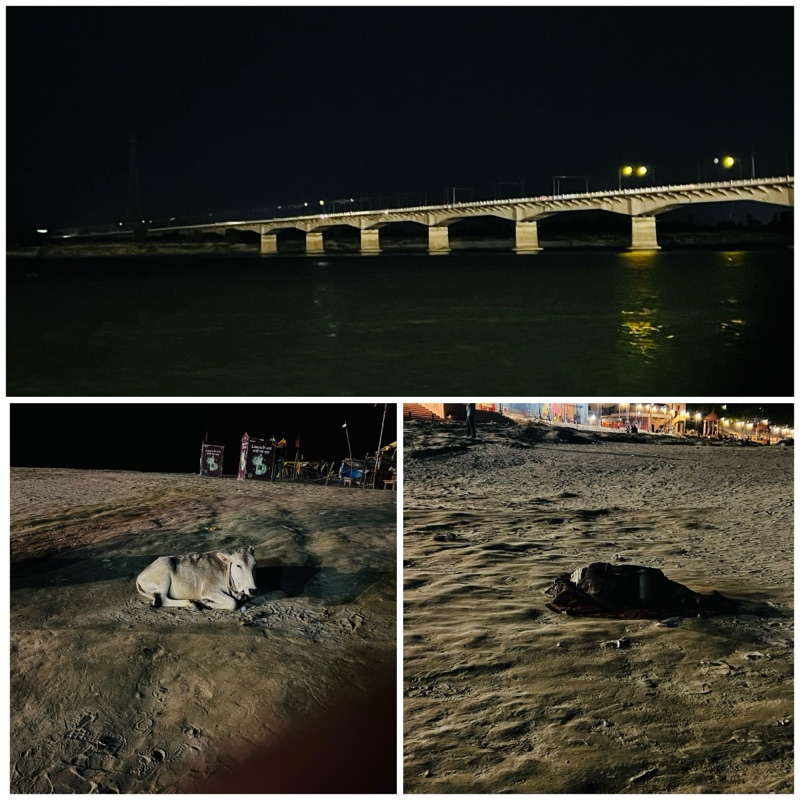
https://youtu.be/zO9W4E1YLaQ?si=tcqau6f04MJo0qWr
The famous poem “Sarayuvilekke”by ONV Kurupu
a Chat GPT poem
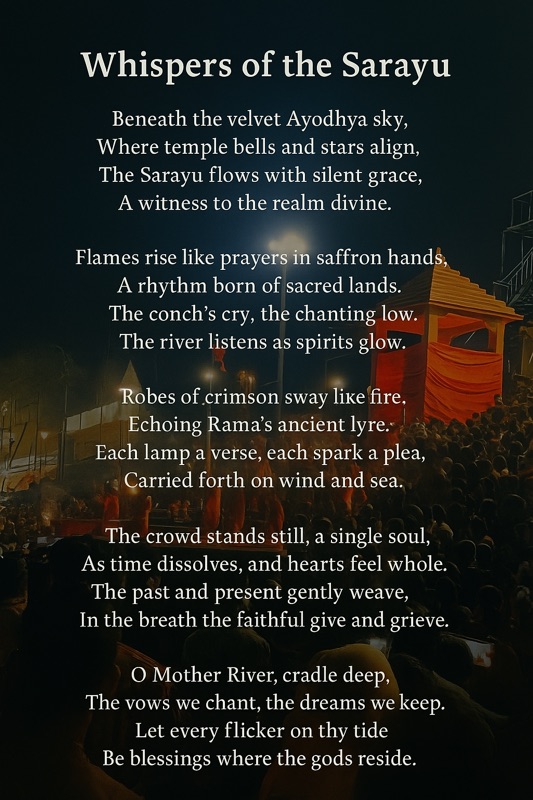
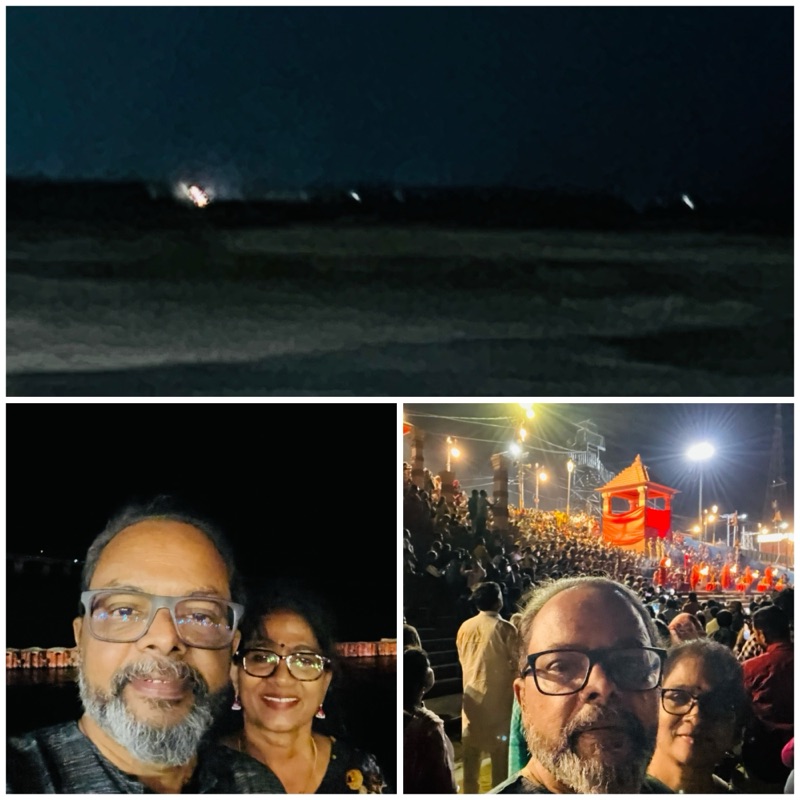
സരയു തീരത്ത് ഞങ്ങളും
Tuesday, April 8, 2025
When the Healer Felt the Hurt: My Journey Through Pain and Healing
Pain is the Concern of the Sufferer
An Experience That Changed My Perspective on Pain
By Dr. Venugopalan P. P.
A January Morning Full of Promise
It was a beautiful January morning in 2017. I was in Coimbatore to attend the National Conference on Indian Paramedics, organized by the EMS division of SEMI—Society for Emergency Medicine in India—at KG Hospital. The venue was electric, filled with over 500 paramedics from across the country.
The inauguration began at 11 a.m., with Padma Shri Awardee Dr. Bakthavatchalam delivering a soul-stirring keynote. SEMI leaders graced the dais, and I was scheduled to speak shortly after. My session focused on the importance of community-based EMS in India and the powerful role that Public-Private Partnerships (PPP) can play. I shared the impactful story of ANGELS (Active Network Group of Emergency Life Savers)—a model that has saved countless lives.
.png) |
| EMT Paramedic Conference at KG Hospital Coimbatore 2017 |
After lunch, I returned to my hotel room for a short break. But the vibrant streets of Gandhipuram, with their famous shopping spots—Kumaran Silks, Pothys—beckoned. I stepped out to pick up a few gifts for Supriya and Neethu.
A Sudden Turn of Events
By 3:30 p.m., my shopping was done. I began the walk back. As I reached the Pothys junction, I joined a group of pedestrians crossing the road. I was the last in the crowd. Despite a red signal, vehicles zipped by in all directions—a typical Indian traffic story.
 |
| Gandhipuram |
Just as I was stepping off the road, something—likely a bike—slammed into my right leg. I crashed to the ground. My shopping bag flew out of my hand. I looked down—my leg was deformed. The pain was instant and unbearable. Yet, there was no bleeding. Someone handed me the bike’s registration number. I slipped it into my pocket, still dazed.
Strangers rushed to help. A few kind souls hailed an auto-rickshaw. One young gentleman rode with me—I never knew his name. I just rested on his shoulder, overwhelmed. He was my first guardian angel that day.
 |
| My guardian angel with Dr. Fabith and Dr. Narendra Jena |
The Pain That Was Overlooked
By 4:00 p.m., I was in the casualty of a well-known orthopedic hospital. I was put on a stretcher. The pain in my ankle was now searing—every movement was excruciating. Someone inserted an IV line. I waited, hoping for pain relief. It never came.
No one assessed my pain score. No one asked me about my pain. As a physician who teaches acute pain management, this was disheartening. By 4:45 p.m., an X-ray confirmed a bimalleolar fracture. A nurse approached with an intramuscular injection and asked me to expose my gluteal region.
I asked, “What is this for?”
“Painkiller,” he replied.
I said, “But I already have an IV line. Why not give IV analgesia? My pain score is 9/10.”
His answer was simple: “The doctor ordered this.”
I never even saw that doctor.
I refused the injection. Later, I learned the ED didn’t have access to IV opioids. They simply lacked the infrastructure or protocol to manage pain adequately.
Meeting the Godman in Scrubs
By then, my SEMI colleagues—Dr. Fabith, Dr. Jena, Dr Sai Surendar, Dr. Srinath, and Dr. Saravana—had arrived and expedited my care. Around 6:00 p.m., I was taken to the pre-operative room.
My pain was now 10/10.
And that’s when I met the real God.
A man appeared beside me in OT attire. Calm, composed. He gently touched my hand and felt my pulse. His presence was reassuring.
He lowered his mask and said, “I am Dr. Bala Venket, Anaesthesiologist.”
 |
| Dr.Bala Venket https://aosrapm.org/pdf/Dr-J-Balavenkatasubramanian.pdf https://drbalavenkat.org/ |
His voice was soft, his demeanor divine.
He took a quick history and told me, “Don’t worry. You’ll feel comfortable soon.”
He gave me an IV opioid. Within minutes, my pain dropped to 4/10. Then he said he’d perform a popliteal nerve block using ultrasound. I panicked, worried they’d move me or turn me prone, worsening the pain. But Dr. Bala gently assured me:
“You’ll stay in the same position. I might tilt you slightly. You won’t feel more pain.”
Within five minutes, the block was done. My pain score dropped to zero. Absolute stillness. A cold hand touched mine again, and I felt a sense of peace that’s hard to describe.
 |
| USG-guided Popliteal Nerve block |
I was then wheeled into the OT, where the orthopedic team performed a closed reduction and applied a slab. I decided to have the surgery done later in Calicut, closer to home. Interestingly, I don’t even recall the orthopedic surgeon’s name. But I remember Dr. Bala Venket vividly—because he relieved my pain and touched my soul.
The Takeaway
Pain is the concern of the sufferer. But too often, we, the treating physicians, overlook it.
That day, I was a patient—and I felt the neglect firsthand. Despite all our advancements, adequate pain management is still missing in many Indian emergency departments. It is not about luxury. It is about dignity.
The Montreal Declaration, adopted at the International Pain Summit in 2010, proclaims that access to pain relief is a fundamental human right.
Emergency Physicians must:
-
Assess pain scores.
-
Be trained in the use of opioids and nerve blocks.
-
Never hesitate to treat pain adequately.
-
Speak to patients with compassion and humanity.
A well-done nerve block is not a fancy skill. It can change a patient’s entire experience. And a kind touch, a warm smile, a few comforting words—these are sometimes the best medicine.
Gratitude
I met Dr. Bala again at a function in Delhi in 2023 and personally expressed my heartfelt gratitude. He is not just an anesthesiologist—he is a healer in the truest sense of the word.
 |
| Dr Bala Venket, The man with a Magical touch https://www.gangahospital.com/awards_doc_nat_oration/29 |
This story does not end here. It continues—with resilience, recovery, and reflections.
Part 2: Recovery and Resilience – Coming Soon
Monday, March 31, 2025
Untold Story of Chennai Floods 2015: A Mission of Rescue, Relief, and Recovery
 |
| www.docvenu.com |
Untold Story of Chennai Floods 2015: A Mission of Rescue, Relief, and Recovery
The 2015 Chennai floods remain etched in history as one of the most devastating natural disasters to have struck the city. Triggered by heavy rainfall from the northeast monsoon between November and December, the catastrophe claimed over 500 lives and displaced more than 1.8 million people. The economic impact was staggering, with losses estimated between ₹200 billion (US$2 billion) and ₹1 trillion (US$11 billion), making it one of the costliest disasters of that year.
A Call to Action: Rising to the Challenge
As responsible citizens, we decided to extend our support to Chennai during its most critical hour, both in the acute phase of disaster relief and potentially in the rehabilitation phase. Under the visionary leadership of Dr. Azad Moopen, Chairman of Aster DM Healthcare, and through the global initiative Aster Volunteers, we mobilized resources and expertise to provide immediate medical assistance. Although Aster Volunteers had not been formally established in 2015, the spirit of humanitarian service was deeply ingrained in the ethos of Aster DM Healthcare.
At that time, I was serving as the Director of Emergency Medicine at Aster DM Healthcare, coordinating emergency medicine activities across Aster institutions in India, including Aster MIMS Calicut, Aster MIMS Kottakkal, Aster Medcity Kochi, DM WIMS, and Aster CMI Bangalore. The group's CEO, Dr. Harish Pillai, was highly committed to social initiatives, and his proactive leadership enabled us to act swiftly.
 |
| Dr Harish Pillai |
Initial Challenges: Navigating Chaos and Political Realities
In the initial days, access to Chennai was virtually impossible due to submerged roads and disrupted communication networks. Three days after the flooding began, I managed to contact some of my Emergency Physician (EP) colleagues in Chennai, including Dr. Tausif Thanganvadi, Dr. Sai Surendran, and Dr. Adil. They painted a grim picture—while rescue and relief efforts were reasonably efficient within the metropolitan limits, the outskirts and suburbs of Chennai were in a state of complete neglect. No medical attention was reaching the camps located in these peripheral areas.
 |
| Dr Tausif Thanganvadi - Renowned EP and well-known Radio Jockey in Chennai, played a pivotal role in Chennai flood relief |
 |
| On the way to Chennai |
Mobilizing the Medical Relief Team: A Herculean Effort
Recognizing the urgency, we assembled a 48-member medical relief team comprising:
 |
| The medical Aid team for the Chennai floods 2015 from Aster DM Healthcare |
20 Doctors: Emergency Physicians, EM residents, Family Physicians, Pediatricians, and General Physicians.
15 EMS Personnel and Nurses
5 Pharmacists
4 Driver-EMS Personnel
4 Ambulance Assistants
The team was drawn from Aster MIMS Calicut, Aster MIMS Kottakkal, and Aster Medcity Kochi. We procured essential medications worth ₹25,00,000, including antibiotics, painkillers, oral rehydration salts (ORS), anti-diabetics, anti-hypertensives, and other necessary drugs. Along with life-saving equipment and medical camp gadgets, we hired a bus and mobilized three ACLS Mobile ICUs for the mission.
 |
| Mission Chennai 2015 |
The Journey to Chennai: A Mission Begins
On December 9, 2015, at 4:00 PM, the mission was flagged off by Mr. Babu Parasala, Kozhikode District Panchayat President, in the presence of Sri V.M. Vinu, a renowned film director, Mr.Kamal Varadoor the President Press Club and Mrs. Sudheera K.P., a celebrated writer. Senior administrators from Aster MIMS graced the occasion. By 7:00 PM, we crossed the Kerala border, with real-time updates being provided by Dr. Sai Surendran, who used his influence in Tamil Nadu to ensure safe passage and smooth coordination.
 |
| Mission Chennai 2015 , Flagged off by Sri Babu Parassala |
Connecting with Ground Reality: Partnering with Local Heroes
Upon entering Chennai, we were connected to Mr. Zikander, the head of a dynamic NGO - India Thowheed Jumaah(INTJ) actively involved in flood relief operations. His team had extensive knowledge of the ground reality in the outskirts of Chennai, where medical relief was either lacking or minimal. They had ample supplies of food, water, clothing, and utensils but lacked adequate medical aid.
 |
| Mr Zikkander Bai( Black shirt), who coordinated the camps locally |
Mr. Zikander’s team welcomed us with open arms, providing comfortable accommodation and food. His volunteers treated us like family and took us to various flood-affected villages in the suburbs of Chennai, where medical assistance was desperately needed.
Conducting Medical Camps: Bringing Relief to the Forgotten

Campsites

Over the next 7 days, we conducted 5 to 6 medical camps daily, with an average attendance of 200 to 300 patients per camp. This meant that we attended to over 1,000 patients every day and served nearly 10,000 patients during the mission. Several mosques and schools had been converted into makeshift camp sites. The primary health issues we encountered included:
Skin infections, especially fungal
Respiratory tract infections
Gastrointestinal infections
Exacerbation of diabetes and hypertension
Trauma and fractures
Asthma and COPD exacerbations
Convulsions and hypoglycemic attacks

Media coverage
The Epidemic Scare: A Critical Intervention
We identified 18 cases of pediatric diarrheal disease in two campsites. According to national guidelines, any cluster of more than five such cases in a single site during a disaster scenario warrants notification and investigation. However, when we attempted to report the cases, we faced significant resistance from local authorities and district medical officials. They were hesitant to notify the outbreak, fearing government action and negative media attention.
 |
| Pediatric gastroenteritis -Epidemics |
 |
| Large numbers of pediatric cases were reported |
This placed us in a moral dilemma—to report and face possible local hostility or stay silent and compromise public health. Thankfully, Dr. Tausif took charge and directly reported the situation to national authorities. Within five minutes, directions came from national authorities to the state and district authorities, initiating an epidemic investigation and immediate disinfection efforts for local water sources. Thanks to these efforts, no mortality was reported from this outbreak.
 |
| Dr Sai Surendar Chennai coordinated and arranged a reception for all team members in Chennai |
A Mission Fulfilled: Gratitude and Recognition
After completing 7 days of intense service, we returned to Kerala with a sense of deep satisfaction and gratitude. The Emergency Physicians of Chennai, under SEMI Tamil Nadu, organized a special reception for our team, where all EPs of Chennai were present. Later, at the national level, SEMI awarded Aster DM Healthcare and me the "Bravery Award 2015" for our commitment and contribution.
 |
| SEMI Bravery Award 2015 |
A Moment of Lasting Bond: Chennai Honors Kerala’s Heroes
Three months after the floods, a team from Chennai led by Mr. Zikander traveled to Kochi to felicitate and honor all the warriors from Kerala who supported Chennai during its darkest hour. The event was held at Aster Medcity Kochi, marking a moment of heartfelt gratitude and lasting friendships.
 |
| A memento from INTJ-an NGO supports conducting medical Camps in outreach Chennai |
Conclusion: An Everlasting Memory
The 2015 Chennai floods left behind a trail of destruction, but they also revealed the power of humanity and compassion. Our mission not only provided immediate relief but also helped contain a potential epidemic, ensuring the safety of thousands. The memories of this mission continue to inspire us, reminding us that in the face of adversity, true service lies in standing by those in need.
 |
| National CME/Workshop on Lesson learned in Chennai floods Conducted in Kochi. Dr Tausif, Dr Venu, Dr Sai Surendar ,Dr Adil , Dr Renuka |
"Service to humanity is the best work of life." Our Chennai mission was a testament to that philosophy, and its lessons will resonate forever in our hearts.
 |
| Received memento from TN Governor Rosayya, courtesy to Dr Narendranath Jena |
Asianet Lifetime achievement Award 2025-Special Jury mention
“Honoured to receive the Asianet Healthcare Award 2025 – Special Jury Mention in the Lifetime Achievement category. It’s a moment of pride a...

-
https://www.facebook.com/Emcon2013 EMCON 2013: The Untold Story of Rapid Action and Evacuation in the History of Medical Conferences The ye...
-
The Dream Takes Shape February 18, 2011 , is a day that will forever remain etched in my memory. It was the day we had chosen to launch our ...
-
Landing in No Man’s Land: An Abrupt Diversion in My Professional Life The years 2006 and 2007 were turning points in my li...





